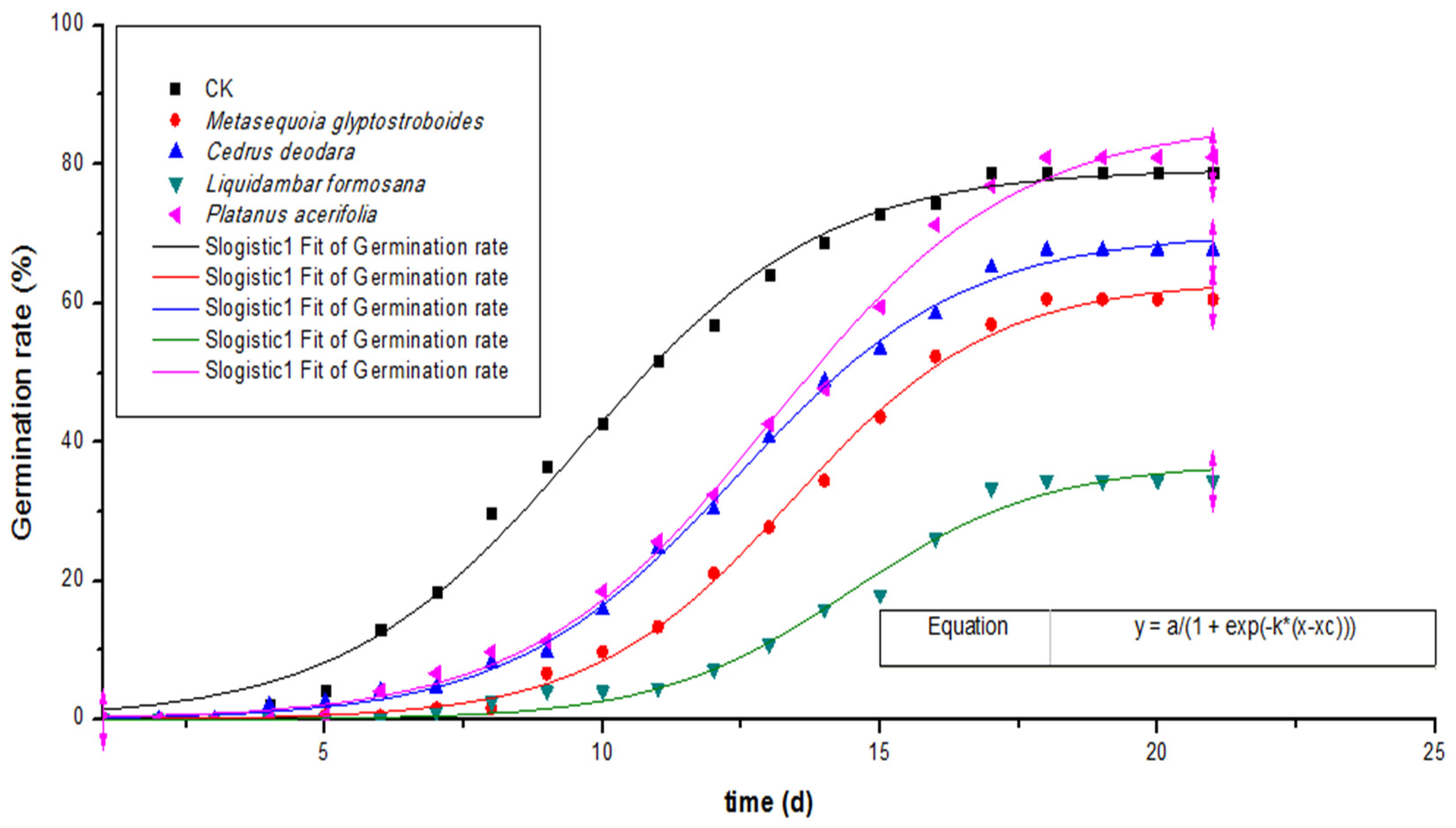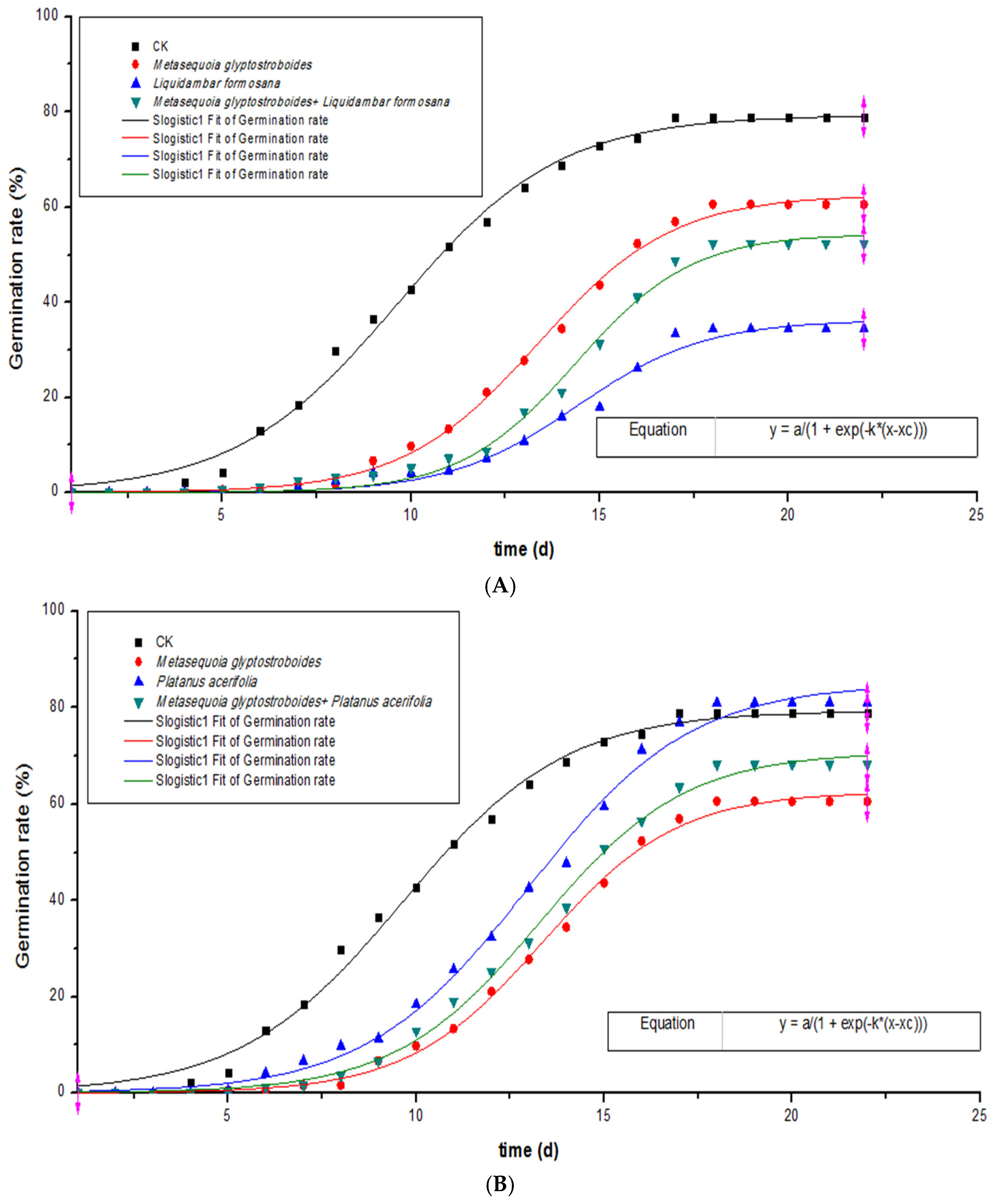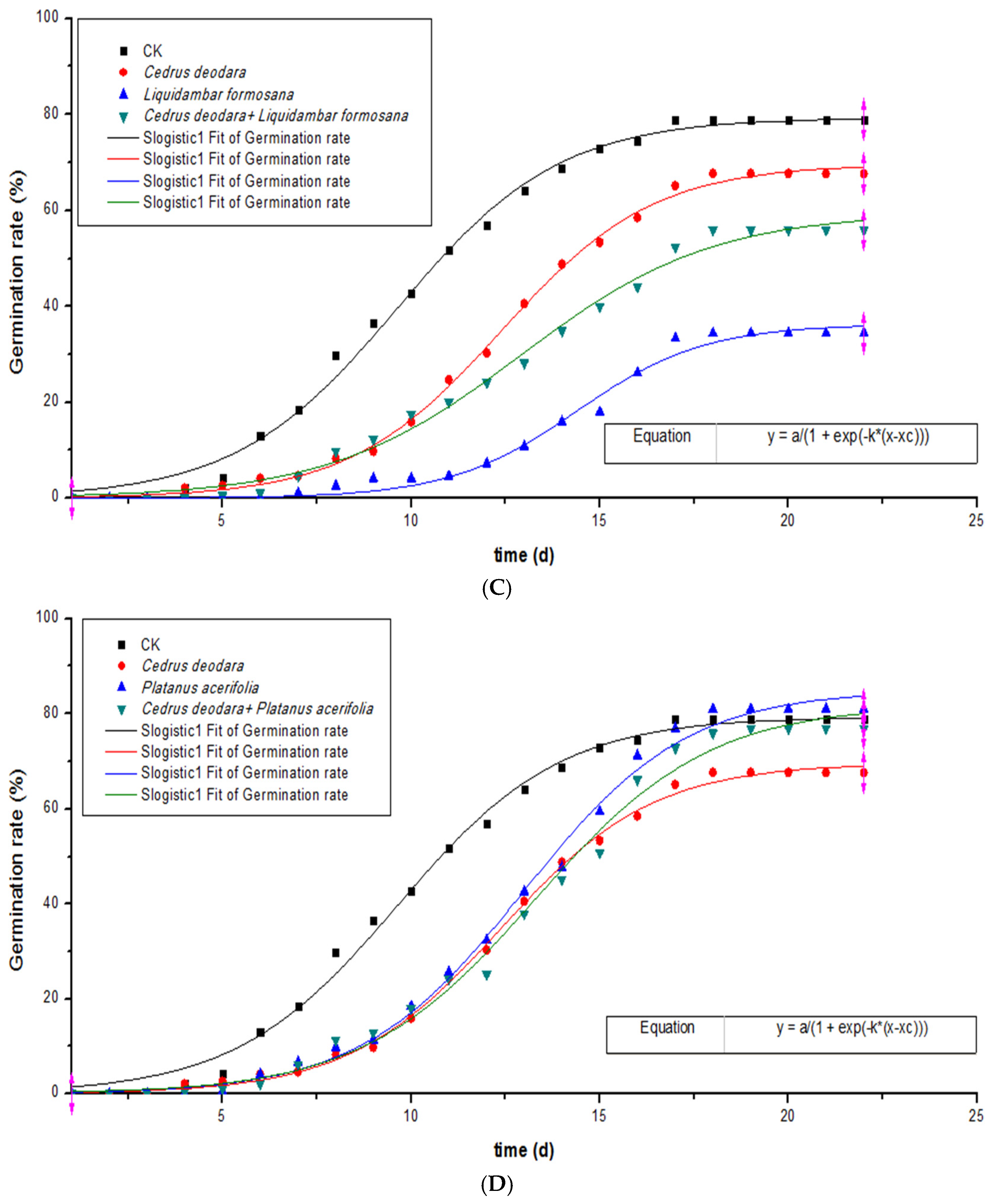Responses of Sesamum indicum to Allelopathy of Coniferous and Broadleaved Trees
Abstract
1. Introduction
2. Materials and Methods
2.1. Target Plant
2.2. Methods
2.2.1. Allelopathic Sources—Preparation of Leaf Aqueous Extracts
2.2.2. Facility Preparation
2.2.3. Seed Germination
2.2.4. Measurement of Germination Rate and Germination Index
2.2.5. Measurement of the Root Length, Height, and Fresh Weight of Seedling
2.2.6. Allelopathic Response Index and Synthesis Effect Index
2.3. Statistical Analysis
3. Results
3.1. Allelopathy of Different Leaf Extracts to Germination of S. indicum Seeds
3.1.1. Seed Germination Rate
3.1.2. Seed Germination Index
| Treatment | Germination Rate (%) | Germination Index |
|---|---|---|
| Control | 78.97 ± 3.20 de | 31.66 ± 2.08 g |
| Metasequoia glyptostroboides (coniferous) | 60.51 ± 1.78 bc | 13.65 ± 1.15 bc |
| Cedrus deodara (coniferous) | 67.69 ± 6.71 cd | 18.83 ± 4.36 def |
| Liquidambar formosana (broadleaved) | 34.36 ± 2.35 a | 6.90 ± 1.53 a |
| Platanus acerifolia (broadleaved) | 81.03 ± 3.20 e | 20.88 ± 2.08 f |
| Metasequoia glyptostroboides + Liquidambar formosana | 52.31 ± 4.07 b | 10.56 ± 2.83 ab |
| Metasequoia glyptostroboides + Platanus acerifolia | 68.21 ± 2.35 cde | 15.56 ± 1.53 cde |
| Cedrus deodara + Liquidambar formosana | 55.90 ± 6.94 bc | 15.46 ± 4.51 cd |
| Cedrus deodara + Platanus acerifolia | 76.92 ± 5.33 de | 19.46 ± 3.46 ef |
3.1.3. Seed Germination Process
3.2. The Effects of Different Leaf Extracts on Seedling Growth of S. indicum
3.2.1. Seedling Height
3.2.2. Root Length
3.2.3. Fresh Weight
| Treatment | Seedling Height (cm) | Root Length (cm) | Fresh Weight (g) |
|---|---|---|---|
| Control | 1.70 ± 0.65 a | 1.99 ± 0.35 b | 1.46 ± 0.06 d |
| Metasequoia glyptostroboides | 1.45 ± 0.08 a | 1.38 ± 0.31 ab | 1.13 ± 0.07 bcd |
| Cedrus deodara | 1.21 ± 0.56 a | 1.30 ± 0.77 ab | 1.13 ± 0.14 bcd |
| Liquidambar formosana | 1.35 ± 0.31 a | 1.25 ± 1.30 ab | 0.77 ± 0.22 a |
| Platanus acerifolia | 1.65 ± 0.26 a | 1.44 ± 2.05 ab | 1.38 ± 0.14 cd |
| Metasequoia glyptostroboides + Liquidambar formosana | 1.36 ± 0.15 a | 1.19 ± 0.12 b | 1.06 ± 0.05 abc |
| Metasequoia glyptostroboides + Platanus acerifolia | 1.11 ± 0.30 a | 0.99 ± 0.44 b | 0.81 ± 0.07 ab |
| Cedrus deodara + Liquidambar formosana | 1.22 ± 0.47 a | 1.00 ± 0.31 b | 0.95 ± 0.11 ab |
| Cedrus deodara + Platanus acerifolia | 1.36 ± 0.43 a | 1.02 ± 0.20 b | 0.92 ± 0.14 ab |
3.3. Synthesis Effect Index of S. indicum After Treatment of Leaf Extracts
4. Discussion
5. Conclusions
Author Contributions
Funding
Informed Consent Statement
Data Availability Statement
Acknowledgments
Conflicts of Interest
References
- Burton, M.; Franco, J.; Gennaro, J.; Johnson, H.; Mitchell, A.; Yoho, J.G. The International Book of the Forest; Mitchell Beazley Publishers: London, UK, 1981. [Google Scholar]
- Valera-Burgos, J.; Díaz-barradas, M.C.; Zunzunegui, M. Effects of Pinus pinea litter on seed germination and seedling performance of three Mediterranean shrub species. Plant Growth Regul. 2012, 66, 285–292. [Google Scholar] [CrossRef]
- Li, D.W.; Wang, D.M.; Yao, W.X. Autotoxicity of Pinus tabulaeformis and its ecology significance. Sci. Silvae Sin. 2010, 46, 174–178. (In Chinese) [Google Scholar]
- Huang, L.; Yu, Y.; An, X.; Yu, L.; Xue, Y. Interspecific association of main woody plants in tiankeng forests of Dashiwei Tiankeng Group, Guangxi. Sink. Guihaia 2021, 41, 695. [Google Scholar]
- Zhu, M.Q.; Wang, Y.; Xu, Z.Q.; Cui, J.Z.; Yuan, Y.X. Review on allelopathic effect of woody plants. World For. Res. 2008, 21, 19–24. (In Chinese) [Google Scholar]
- Peng, S.L.; Shao, H. Research significance and foreground of allelopathy. Chin. J. Appl. Ecol. 2001, 12, 780–786. (In Chinese) [Google Scholar]
- Rejila, S.; Vijayakumar, N. Allelopathic effect of Jatropha curcas on selected intercropping plants (green chilli and sesame). J. Phytol. 2011, 3, 1–3. [Google Scholar]
- Rice, E.L. Allelopathy-An update. Bot. Rev. 1979, 45, 15–109. [Google Scholar] [CrossRef]
- Rice, E.L. Allelopathy; Academic Press: New York, NY, USA, 1984; pp. 1–267. [Google Scholar]
- Shu, K.; Meng, Y.J.; Shuai, H.W.; Liu, W.G.; Du, J.B.; Liu, J.; Yang, W.Y. Dormancy and germination: How does the crop seed decide? Plant Biol. 2015, 17, 1104–1112. [Google Scholar] [CrossRef]
- Macías, F.A.; Molinillo, J.M.; Galindo, J.C.G.; Varela, R.M.; Simonet, A.M.; Castellano, D. The use of allelopathic studies in the search for natural herbicides. J. Crop Prod. 2001, 4, 237–255. [Google Scholar] [CrossRef]
- Weston, L.A.; Alsaadawi, I.S.; Baerson, S.R. Sorghum allelopathy-From ecosystem to molecule. J. Chem. Ecol. 2013, 39, 142–153. [Google Scholar] [CrossRef]
- Lin, S.Z.; Huang, S.G.; Cao, G.Q. Autointoxication of Chinese fir. Chin. J. Appl. Ecol. 1999, 10, 661–664. (In Chinese) [Google Scholar]
- Li, Z.F.; Yang, Y.Q.; Xie, D.F.; Zhu, L.F.; Zhang, Z.G.; Lin, W.X. Identification of autotoxic compounds in fibrous roots of Rehmannia (Rehmannia glutinosa Libosch.). PLoS ONE 2012, 7, e28806. [Google Scholar] [CrossRef] [PubMed]
- Cruz-Ortega, R.; Anaya, A.L.; Hernández-Bautista, B.E.; Laguna-Hernández, G. Effects of allelochemical stress produced by Sicyos deppei on seedling root ultrastructure of Phaseolus vulgaris and Cucurbita ficifolia. J. Chem. Ecol. 1998, 24, 2039–2057. [Google Scholar] [CrossRef]
- Liu, T.Y.; Ye, N.H.; Wang, X.; Das, D.; Tan, Y.X.; You, X.; Long, M.; Hu, T.; Dai, L.; Zhang, J.H.; et al. Drought stress and plant ecotype drive microbiome recruitment in switchgrass rhizosheath. J. Integr. Plant Biol. 2021, 63, 1753–1774. [Google Scholar] [CrossRef] [PubMed]
- Zhang, Z.; Liu, Y.; Yuan, L.; Weber, E.; van Kleunen, M. Effect of allelopathy on plant performance: A meta analysis. Ecol. Lett. 2021, 24, 348–362. [Google Scholar] [CrossRef] [PubMed]
- Schandry, N.; Becker, C. Allelopathic Plants: Models for Studying Plant–Interkingdom Interactions. Trends Plant Sci. 2019, 25, 176–185. [Google Scholar] [CrossRef]
- Kong, C.H.; Xuan, T.D.; Khanh, T.D.; Tran, H.; Trung, N.T. Allelochemicals and signaling chemicals in plants. Molecules 2019, 24, 2737. [Google Scholar] [CrossRef] [PubMed]
- Macias, F.A.; Mecias, F.J.; Molinillo, J.M. Recent advances in allelopathy for weed control: From knowledge to applications. Pest. Manag. Sci. 2019, 75, 2413–2436. [Google Scholar] [CrossRef] [PubMed]
- Xu, Y.; Chen, X.; Ding, L.; Kong, C.H. Allelopathy and allelochemicals in grasslands and forests. Forests 2023, 14, 562. [Google Scholar] [CrossRef]
- Sun, G.; Luo, P.; Wu, N.; Qiu, P.F.; Gao, Y.H.; Chen, H.; Shi, F.S. Stellera chamaejasme L. increases soil N availability, turnover rates and microbial biomass in an alpine meadow ecosystem on the eastern Tibetan Plateau of China. Soil Biol. Biochem. 2009, 41, 86–91. [Google Scholar] [CrossRef]
- He, W.; Detheridge, A.; Liu, Y.; Wang, L.; Wei, H.; Griffith, G.W.; Scullion, J.; Wei, Y. Variation in soil fungal composition associated with the invasion of Stellera chamaejasme L. in Qinghai–Tibet plateau grassland. Microorganisms 2019, 7, 587. [Google Scholar] [CrossRef]
- Jin, H.; Guo, H.; Yang, X.; Xin, A.; Liu, H.; Qin, B. Effect of allelochemicals, soil enzyme activity and environmental factors from Stellera chamaejasme L. on rhizosphere bacterial communities in the northern Tibetan Plateau. Arch. Agron. Soil Sci. 2022, 68, 547–560. [Google Scholar] [CrossRef]
- Oracz, K.; Voegele, A.; Tarkowská, D.; Jacquemoud, D.; Turečková, V.; Urbanová, T.; Strnad, M.; Sliwinska, E.; Leubner-Metzger, G. Myrigalone A inhibits Lepidium sativum seed germination by interference with gibberellin metabolism and apoplastic superoxide production required for embryo extension growth and endosperm rupture. Plant Cell Physiol. 2012, 53, 81–95. [Google Scholar] [CrossRef] [PubMed]
- Li, X.F.; Jiao, H.; Yuan, Y.; Tian, S.N. Allelopathic effects and chemincal components of the volatiles from Cedrus deodara leaves and branches. Ecol. Environ. Sci. 2015, 24, 263–269. (In Chinese) [Google Scholar]
- Weitbrecht, K.; Müller, K.; Leubner-Metzger, G. First off the mark: Early seed germination. J. Exp. Bot. 2011, 62, 3289–3309. [Google Scholar] [CrossRef] [PubMed]
- Han, C.M.; Pan, K.W.; Wu, N.; Wang, J.C.; Li, W. Allelopathic effect of ginger on seed germination and seedling growth of soybean and chive. Sci. Hortic. 2008, 116, 330–336. [Google Scholar] [CrossRef]
- Kato-Noguchi, H.; Mori, K.; Iwasaki, A.; Suenaga, K. Allelopathy and Allelochemicals in Chamaecyparis obtusa Leaves for the Development of Sustainable Agriculture. Agronomy 2024, 14, 1557. [Google Scholar] [CrossRef]
- Bi, J.; Blanco, J.A.; Seely, B.; Kimmins, J.P.; Ding, Y.; Welham, C. Yield decline in Chinese-fir plantations: A simulation investigation with implications for model complexity. Can. J. For. Res. 2007, 37, 1615–1691. [Google Scholar] [CrossRef]
- Wang, J.H.; Chen, T.; Lin, W.X. Plant allelopathy types and their application in agriculture. Chin. J. Eco-Agric. 2013, 21, 1173–1183. (In Chinese) [Google Scholar] [CrossRef]
- Kato-Noguchi, H. Bioactive compounds involved in the formation of the sparse understory vegetation in pine forests. Curr. Org. Chem. 2021, 25, 1731–1738. [Google Scholar] [CrossRef]
- Liu, Z.L.; Wang, Q.C.; Hao, L.F. Interspecific allelopathic effect of different organs’ aqueous extracts of Betula platyphylla and Larix olgensis on their seed germination and seedling growth. Chin. J. Appl. Ecol. 2011, 22, 3138–3144. (In Chinese) [Google Scholar]
- Miles, H.H.; Salom, S.; Shively, T.J.; Bielski, J.T.; McAvoy, T.J.; Fearer, C.J. A review of potential biological controls for Ailanthus altissima. Ann. Entomol. Soc. Am. 2024, saae041. [Google Scholar] [CrossRef]
- Chu, C.J.; Mortimer, P.; Wang, H.C.; Wang, Y.F.; Liu, X.B.; Yu, S.X. Allelopathic effects of Eucalyptus on native and introduced tree species. For. Ecol. Manag. 2014, 323, 79–84. [Google Scholar] [CrossRef]
- Zhang, D.J.; Zhang, J.; Yang, W.Q.; Wu, F. Potential allelopathic effect of Eucalyptus grandis across a range of plantation ages. Ecol. Res. 2010, 25, 13–23. [Google Scholar] [CrossRef]
- Chen, L.C.; Wang, S.L.; Wang, P.; Kong, C.H. Autoinhibition and soil allelochemical (cyclic dipeptide) levels in replanted Chinese fir (Cunninghamia lanceolata) plantations. Plant Soil 2014, 374, 793–801. [Google Scholar] [CrossRef]
- Liu, X.B.; Herbert, S.J. Fifteen years of research examining cultivation of continuous soybean in northeast China: A review. Field Crops Res. 2002, 79, 1–7. [Google Scholar] [CrossRef]
- Fernandez, M.; Malagoli, P.; Gallet, C.; Fernandez, C.; Vernay, A.; Ameglio, T.; Balandier, P. Investigating the role of root exudates in the interaction between oak seedlings and purple moor grass in temperate forest. For. Ecol. Manag. 2021, 491, 119175. [Google Scholar] [CrossRef]
- Wu, J.M.; Wang, H.B.; Tang, L.J.; Liu, G.P.; Wang, X.S.; Wu, B.G. Effect of larch litter on the growth of ash in mixture plantation. J. Northeast For. Univ. 2000, 28, 1–3. (In Chinese) [Google Scholar]
- Yang, X.L.; Wang, H.; He, J.J.; Zhang, Z.; Zhao, W. Study on allelopathy of Gikgo biloba leaf aqueous extract to wheat. Anhui Agric. Sci. 2010, 38, 12885–12887. (In Chinese) [Google Scholar]
- Zhang, C.Y.; Lin, W.X. Continuous cropping obstacle and allelopathic autotoxicity of medicinal plants. Chin. J. Eco-Agric. 2009, 17, 189–196. (In Chinese) [Google Scholar] [CrossRef]
- Yang, M.; Zhang, X.D.; Xu, Y.G.; Mei, X.Y.; Jiang, B.B.; Liao, J.J.; Yin, Z.B.; Zheng, J.F.; Zhao, Z.; Fan, L.M.; et al. Autotoxic ginsenosides in the rhizosphere contribute to the replant failure of Panax notoginseng. PLoS ONE 2015, 10, e0118555. [Google Scholar] [CrossRef] [PubMed]
- Liu, Y.J.; Arens, N.C.; Li, C.S. Range change in Metasequoia: Relationship to palaeoclimate. Bot. J. Linn. Soc. 2007, 154, 115–127. [Google Scholar] [CrossRef]
- Matuda, Y.; Iwasaki, A.; Suenaga, K.; Kato-Noguchi, H. Allelopathy and Allelopathic Substances of Fossil Tree Species Metasequoia glyptostroboides. Agronomy 2022, 12, 83. [Google Scholar] [CrossRef]
- Morita, S.; Ito, M.; Harada, J. Screening of an allelopathic potential in arbor species. Weed Biol. Manag. 2010, 5, 26–30. [Google Scholar] [CrossRef]
- Wei, C.; Chen, J.Q.; Zhang, P.F.; Zhang, X.; Chen, G. The biossay of allelopathy of Metasequoia glyptostroboides in agroforesty system. J. Nanjing For. Univ. 1999, 23, 85–88. (In Chinese) [Google Scholar]
- Khamare, Y.; Chen, J.; Marble, S.C. Allelopathy and its application as a weed management tool: A review. Front. Plant Sci. 2022, 13, 1034649. [Google Scholar] [CrossRef]
- Dias, L.S.; Pereira, I.P.; Dias, A.S. Allelopathy, seed germination, weed control and bioassay methods. Allelopath. J. 2016, 37, 31–40. [Google Scholar]
- Dorning, M.; Cipollini, D. Leaf and root extracts of the invasive shrub, Lonicera maackii, inhibit seed germination of three herbs with no autotoxic effects. Plant Ecol. 2006, 184, 287–296. [Google Scholar] [CrossRef]
- Singh, A.A.; Rajeswari, G.; Nirmal, L.A.; Jacob, S. Synthesis and extraction routes of allelochemicals from plants and microbes: A review. Rev. Anal. Chem. 2021, 40, 293–311. [Google Scholar] [CrossRef]
- Wang, C.; Wu, B.; Jiang, K. Allelopathic Effects of Canada Goldenrod Leaf Extracts on the Seed Germination and Seedling Growth of Lettuce Reinforced under Salt Stress. Ecotoxicology 2019, 28, 103–116. [Google Scholar] [CrossRef] [PubMed]
- Schittko, C.; Wurst, S. Above- and belowground effects of plant-soil feedback from exotic Solidago canadensis on native Tanacetum vulgare. Biol. Invasions 2014, 16, 1465–1479. [Google Scholar] [CrossRef]
- Singh, H.P.; Batish, D.R.; Kohli, R.K. Autotoxicity: Concept, organisms, and ecological significance. Crit. Rev. Plant Sci. 1999, 18, 757–772. [Google Scholar] [CrossRef]



| Treatment | Allelopathic Response Index (RI) | Synthesis Effect (SE) | ||||
|---|---|---|---|---|---|---|
| Germination Rate | Germination Index | Seedling Height | Root Length | Fresh Weight | ||
| Control | - | - | - | - | - | - |
| Metasequoia glyptostroboides | −0.31 | −1.32 | −0.17 | −0.44 | −0.29 | −0.51 |
| Cedrus deodara | −0.17 | −0.68 | −0.41 | −0.52 | −0.29 | −0.41 |
| Liquidambar formosana | −1.30 | −3.59 | −0.26 | −0.60 | −0.89 | −1.33 |
| Platanus acerifolia | 0.03 | −0.52 | −0.03 | −0.38 | −0.06 | −0.19 |
| Metasequoia glyptostroboides + Liquidambar formosana | −0.51 | −2.00 | −0.25 | −0.67 | −0.38 | −0.76 |
| Metasequoia glyptostroboides + Platanus acerifolia | −0.16 | −1.03 | −0.53 | −1.01 | −0.81 | −0.71 |
| Cedrus deodara + Liquidambar formosana | −0.41 | −1.05 | −0.39 | −0.99 | −0.53 | −0.67 |
| Cedrus deodara + Platanus acerifolia | −0.03 | −0.63 | −0.25 | −0.95 | −0.58 | −0.49 |
Disclaimer/Publisher’s Note: The statements, opinions and data contained in all publications are solely those of the individual author(s) and contributor(s) and not of MDPI and/or the editor(s). MDPI and/or the editor(s) disclaim responsibility for any injury to people or property resulting from any ideas, methods, instructions or products referred to in the content. |
© 2025 by the authors. Licensee MDPI, Basel, Switzerland. This article is an open access article distributed under the terms and conditions of the Creative Commons Attribution (CC BY) license (https://creativecommons.org/licenses/by/4.0/).
Share and Cite
Liu, Y.; Zhao, B.; Han, Y.; Zou, C.; Wang, C. Responses of Sesamum indicum to Allelopathy of Coniferous and Broadleaved Trees. Ecologies 2025, 6, 21. https://doi.org/10.3390/ecologies6010021
Liu Y, Zhao B, Han Y, Zou C, Wang C. Responses of Sesamum indicum to Allelopathy of Coniferous and Broadleaved Trees. Ecologies. 2025; 6(1):21. https://doi.org/10.3390/ecologies6010021
Chicago/Turabian StyleLiu, Yujia, Bingju Zhao, Yumeng Han, Chunjing Zou, and Chenghuan Wang. 2025. "Responses of Sesamum indicum to Allelopathy of Coniferous and Broadleaved Trees" Ecologies 6, no. 1: 21. https://doi.org/10.3390/ecologies6010021
APA StyleLiu, Y., Zhao, B., Han, Y., Zou, C., & Wang, C. (2025). Responses of Sesamum indicum to Allelopathy of Coniferous and Broadleaved Trees. Ecologies, 6(1), 21. https://doi.org/10.3390/ecologies6010021






